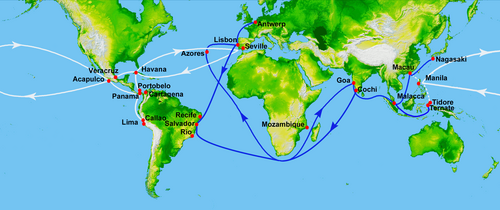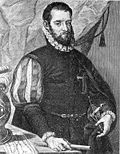Spanish treasure fleet

The Spanish treasure fleet, or West Indies Fleet from Spanish Flota de Indias, was a convoy system adopted by the Spanish Empire from 1566 to 1790. It linked Spain with its territories in America across the Atlantic into the West Indies; and via Acapulco, across the Pacific into the East Indies.
The convoys were general-purpose cargo fleets used for transporting wide varieties of merchandise. These included agricultural produce including spices, sugar, tobacco, lumber; various metal resources of silver, gold; and luxeries such as gems, pearls, silk, and other exotic goods. From the colonies, these were sent back to the Spanish mainland. Passengers and their amenities such as soap, textiles, books and tools were transported in the opposite direction.[1][2] The West Indies fleet was the first permanent transatlantic trade route in history, which consequently spurred the Manila-Acapulco Galleon Trade that became the first permanent trade route across the Pacific.
Spanish Treasure Fleet Media
Pedro Menéndez de Avilés, admiral and designer of the treasure fleet system
Spain claimed most of the Pacific Ocean as its mare clausum during the Age of Discovery.
The Spaniard Amaro Pargo, a corsair and merchant, participated in the West Indies Fleet.
A shipyard on the river Guadalquivir in 16th century Seville: detail from a townscape by Alonso Sánchez Coello
References
- ↑ Marx, Robert: Treasure lost at sea: diving to the world's great shipwrecks. Firefly Books, 2004, page 66. ISBN 1-55297-872-9
- ↑ Marx, Robert: The treasure fleets of the Spanish Main. World Pub. Co., 1968




